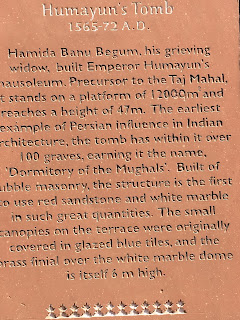Mughal Tombs in New Dehli
At one time, what is now Nw Dehli, was woodland
around the ancient city group that came to be known as Dehli. The ruling
Muslim Moghul dynasty, holding sway over a limited and always contested
territory, contributed relatively little to the lasting architectural legacy of the region. What does still exist is neatly summed up in a triad
of tomb complexes housing an uncertain number of emperors, prime ministers, and
family members. The elaborate sandstone structures, ornamented in Islamic
motifs and topped with great onion domes, surrounded by rectilinear stone walls
and enclosed gardens, house the remains of occupants whose identities remain
uncertain, though logical assumptions can be made. The rulers at the top of the heap might be in
central positions (though it is also thought these positions were given to
favorite wives), and smaller surrounding sarcophagi may well be the children,
even adult children. These grouped sarcophagi are seen in the Lodi and Humayun complexes. The bodies
themselves are buried twenty to thirty feet down in an effort to protect them
from eventual pillage. Some of the questions surrounding identity could be
answered by the pillaging of modern archaeology, but no such endeavor has yet
been undertaken. The content of the
tombs remains a discovery for future archeologists or looters, whoever’s first.
Today, the gardens provide citizens with a bit of
respite from the city’s hustle and bustle and a few breaths of fresher
air. New Dehliites are gregarious while
remaining modest and unobtrusive, so the garden parks are quiet havens even for
tourists. Young people enjoy relative
freedom, so courting couples abound on the weekends.
You can click on any image to enlarge it.
Lodi Garden Tombs
 |
| Lodi Garden Map |
There's much more to see!
 |
| Information plaque outside the main entrance. |
 |
| The main entrance perpendicular to Lodi Road. The upper half-cupola is colorfully painted plaster. |

 |
| Mosque at the eastern border of the tomb complex, seen from outside the main gate. |
 |
| A grand vision through the main entrance. |
 |
| The view from the east side, just through the main entrance. |
 |
| The view from the west side. |
 |
| The honorific tomb. The deceased are generally buried 20-30 feet below, for protection against pillage. |
 |
| Carved plaster ceiling of the dome. The dome is double, with an inner and outer layer, plus this ceiling. |
 |
| A door. |
 |
| Inside the main chamber of Safdarjnng's tomb. |
 |
| The Moguls were an islamic dynasty. |
 |
| Simple tools still in wide use. |
 |
| Delivery vehicle for cement, sand, and gravel for repairs going on just to the left. |
 |
| Entering Safdarjung's tomb, still more. |
 |
| Entering Safdarjung's tomb. |
 |
| Doors to the Modi Mahal (Pearl Palace), one of two palaces built into the walls, this one on the south side, the other opposite on the north side. |
 |
| From inside the tomb, looking northward to the Badshah Bahand (King's Favorite). I missed getting a shot of the Jangli Mahal (Forest Palace) to the west. That was where I took the second panoramic photo of the tomb above. |
 |
| Corner view of Safdarjung's tomb. The galleries below are not interconnecting, as they are in other similar structures, such as Humayun's tomb and the Taj Mahal's outer wall. |
 |
| White marble floor with semi-precious stone inlay. This style is common in Mughal architecture, as well as present-day tourist treasures made mainly in the Agra area (Taj Mahal). The white marble is quarried in that region. |
 |
| Comparing this section to the one above, there is more sign of damage and maybe prize hunting by tourists. Note the missing bits of inlay. |
 |
| This red flower is missing most of the red gemstone inlay. |
 |
| The play of light changes at every turn, with every move. |
 |
| Red sandstone makes up most of the structure, with white marble trim. |
 |
| Discarded rubber stamps are evidence of the habit of bureaucracy. |
 |
| The text can be made out with patient examination. |
 |
| Red sandstone, white marble, and red quartzite. |
 |
| Corner view. |
 |
| A door in the outer wall. |
 |
| The longest stretch of archways in the lower surrounding gallery. Not as extensive as seen in other Mughal structures. |
 |
| Carved foot of the marble doorframe. |
 |
| That's all for Safdarjung's Tomb. |
Humayun’s Tomb Complex
We visited this set of sites with our friends Debbie and Rick during their recent stay in New Delhi, ahead of their trip further afield. Debbie is our friend from the Belgium years. We met her brother, Rick, during his visits to Belgium and quickly felt like old friends. Both retired now, they are enjoying some terrific adventures around the world.
Captions on their way...
 |
Grafitti on monuments...so we a
pproach eternity? |
 |
I think these are both names. Of course, my graffiti
might be: Robert love coffee. |



























































































































The photos tell the story of precision and care used by the artisans so long ago. Well captured angles highlight the geometric shapes. Thanks!
ReplyDelete